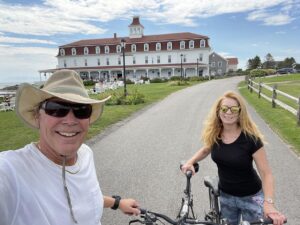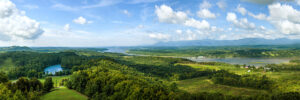Every summer, the Great Lakes offer some of the best cruising grounds in America. What could be better? There’s no salt spray to rinse off and no tides or tidal currents to account for. Add to that a fascinating historical mix of Native Americans, French explorers, religious groups, 19th-century settlers and a larger-than-life cast of characters, and boaters have plenty to keep them amused throughout the Memorial Day to Labor Day season. One such area on Lake Michigan, just of the northwest corner of the lower peninsula of the state of Michigan, is Beaver Island and Little Traverse Bay.
Beaver Island
The Strange Case of King Strang: Whether cruising from Door County, Mackinac Island or the Leelenau Peninsula, Beaver Island is a crossroads port of call that will take you back in time. The pace is slower there, and although it is no longer the isolated community it was just 10 or 15 years ago, it is still a wonderful getaway destination.
Dalwhinnie Bakery, on the main street that rings St. James Harbor, is Beaver Island’s go-to spot for fresh doughnuts and cappuccinos and food for thought while considering a gentleman named James Jesse Strang.
Th e Church of Jesus Christ of Latter Day Saints, also known as the Mormon church, was organized in upstate New York in 1830 by Joseph Smith. Mormons considered Joseph a modern day prophet, and his brother Hyrum was designated as Joseph’s successor. As fate would have it, both Smiths were murdered by a mob in June 1844. With the church founder and his successor dead, the Mormons were in crisis. Brigham Young assumed control over the majority of church members and eventually moved west with them to the Utah Territory.
But other Mormon leaders swayed their followers with their own interpretations of the Latter Day Saints movement, and struck out on their own. James Strang daringly assumed the deceased Joseph Smith’s role as prophet, and although excommunicated by the main Mormon church, he convinced about 12,000 followers that he was the true new leader and moved his headquarters to Beaver Island in 1848, bringing with him a small group of church goers to form his initial colony.
Up until that point, Beaver Island, which had been settled by the Ojibwe tribe, was also inhabited by some white trappers, traders and fishermen. Two years after Strang and his followers arrived, he crowned himself king of the Kingdom of God, wearing a red flannel robe and a shiny tin crown and carrying a wood scepter during his coronation.
King Strang never claimed to rule Beaver Island, but as new Mormons — known as Strangites — migrated to his kingdom, their population soon outnumbered the non-Mormons, which led to open hostility between the groups. Strang was arrested on federal charges of counterfeiting and treason and brought to Detroit for trial. He defended himself so successfully that he ran for the state legislature and won a seat in 1853.
Within his own sect, he harbored a number of adversaries, and one evening in 1856 on Beaver Island, two of them pistol whipped him and then assassinated him with a shot in the back, in full view of the USS Michigan. They claimed sanctuary on the naval vessel and were never punished for their deed. A few weeks later, all the Strangites, almost 2,600 of them, were stripped of their possessions and property and forcibly removed from Beaver Island by a mob.
To fill the vacuum, Irish fishermen from around the Great Lakes and as far away as County Donegal came to Beaver Island. As Irish immigration increased, Beaver Island became known as America’s Emerald Isle. Gaelic was widely spoken, and today the Shamrock Restaurant and Pub, Donegal Danny’s Pub, and McDonough’s Market are all reminders of the island’s Irish heritage.
Beaver Island Marina and Beaver Island Municipal Marina offer slips for visiting boaters. Both are located on St. James Harbor, a well-protected bay at the northeast tip of the island. The harbor and adjacent town were named after none other than James Strang—elevating him from king to saint! While in St. James, don’t miss the Toy Museum, Beaver Head Lighthouse, the Marine Museum and the Old Mormon Print Shop Museum, they are gems of local history, art and memorabilia.
Charlevoix – Beaver Island to Charlevoix: 25 nm
About 25 nautical miles southeast of Beaver Island sits the town of Charlevoix, where Lake Michigan meets Lake Charlevoix along the Michigan coast. The town’s namesake is Pierre Francois Xavier de Charlevoix, a French Jesuit priest and explorer who in 1720 was believed to have weathered a storm on nearby Fisherman’s Island.
In 1869 the Pine River Channel was dredged, connecting Lake Michigan with Lake Charlevoix. This mile-long canalization of the Pine River and Round Lake made Charlevoix one of the busiest ports on the Great Lakes. In the late 1800s, steamships docked here to load on 40 million board feet of lumber each year, harvested from the trees along Lake Charlevoix.
Steamships not only handled freight, they also carried passengers, and brought with them the rest summer residents from Chicago. As railways extended their service to Charlevoix, summer tourists and luxurious hotels followed. By World War I, Charlevoix was a popular resort community for wealthy and middle-class Chicagoans. During Prohibition, Chicago’s infamous gangsters made Charlevoix’s Colonial Club their summer destination of choice.
Yachts seeking transient slips have their choice of the Charlevoix City Marina on the west side of Round Lake, or the two marinas of the Irish Boat Shop on Lake Charlevoix. Dock availability at the City Marina is limited due to the many summer festivals and events downtown, but reservations can be made online or by phone.
One of the most popular attractions in Charlevoix is the guided walking tour of the Mushroom Houses. These landmark homes were designed by the architect Earl Young, and have unique boulder exteriors and rounded, wavy roofs of cedar shakes.
A visit to Castle Farms, a few miles southeast of downtown, is worth a day trip. It was originally built in 1918 by Albert Loeb, the president of Sears Roebuck, as a model dairy farm. From the 1970s through the early 1990s, it served as a rock concert venue. Now it has been restored to its original design, inspired by the stone barns and castles of Normandy, France. It is a family-friendly destination with an outdoor model railroad, a 1918 history museum and a hedge maze.
Bay Harbor – Charlevoix to Bay Harbor: 12 nm
Just over 20 years ago, a developer had a vision to transform a century-old cement plant and mining operation on the south shore of Little Traverse Bay into the ultimate upscale resort, with a deep-water marina, golf course and equestrian center. He dynamited the shoreline that separated the quarry from Lake Michigan, and within 24 hours had created Bay Harbor Lake, as 2.5 billon gallons of water rushed in to the old quarry. Recently Bay Harbor was rated one of the best family boating resorts in the country.
Bay Harbor Lake Marina can accommodate yachts up to 200 feet overall and has many slips on floating docks for boats of all sizes. For some classic American cuisine head to Seventeen Restaurant offering numerous soups, salads, sandwiches and entrees along the waterfront.
Petoskey – Bay Harbor to Petoskey: 4 nm
Located at the southeast corner of Little Traverse Bay, Petoskey was long inhabited by the Odawa people before Europeans arrived. The town was named for 18th-century Chief Ignatius Petosega, the son of a French Canadian fur trader and an Odawa mother. His name means, “where the light shines through the clouds.”
Petoskey is a well-known resort destination, and the Bay View Association, founded by the United Methodist Church in 1875, is its most famous community. Bay View is a National Historic Landmark open to the public
and offering music, worship, lectures and seminars every summer in a setting of beautiful Victorian cottages.
Th e Petoskey City Marina has recently expanded to a 144-slip marina and is right downtown amidst many new restaurants including Julienne Tomatoes and Polish Kitchen and shops in the Gaslight District.
Harbor Springs – Petoskey to Harbor Springs: 3 nm
Situated on the north side of Little Traverse Bay, just three nautical miles across the bay from Petoskey, is Harbor Springs. Protected by the sheltering arm of Harbor Point peninsula, Harbor Springs is the deepest natural harbor on the Great Lakes and has ample docking. These include Harbor Springs Municipal Marina, Irish Boat Shop and Walstrom Marine’s Marina Villa Docks. Going and bicycling are popular activities in Harbor Springs, but it is the unparalleled shopping experience that is the biggest draw. Fine art galleries, unique apparel stores, intimate gift boutiques and local specialty shops abound along the waterfront and nearby streets.
These are just a few small glimpses into the many fascinating communities of the Great Lakes. An avid boat owner can cruise the Great Lakes every summer for years and experience a new adventure each time.
Capt. Jeff Werner has been in the yachting industry for over 25 years. In addition to working as a captain on private and charter yachts, both sail and power, he is a certified instructor for the USCG, US Sailing, RYA and the MCA. He is also the Diesel Doctor, helping to keep your yacht’s fuel in optimal condition for peak performance. For more information, call 239-246-6810, or visit MyDieselDoctor.com. All Marinalife members receive a 10% discount on purchases of equipment, products and supplies from Diesel Doctor.





